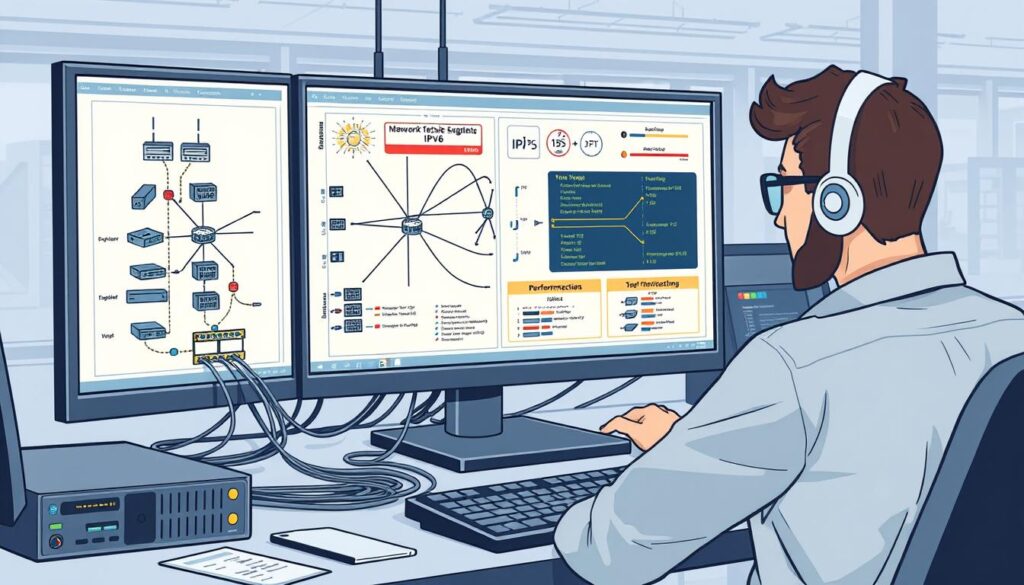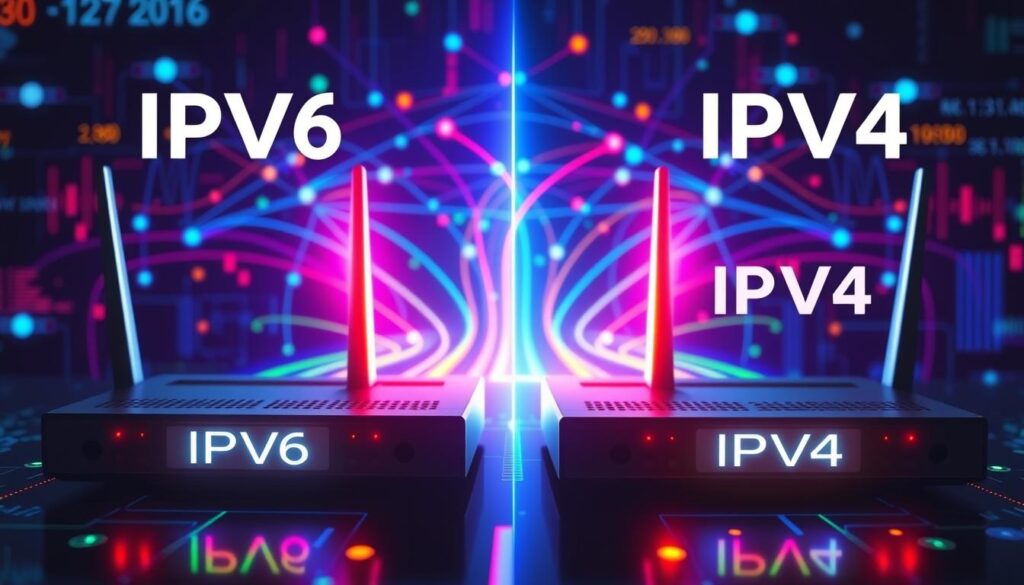iKuai IPv6 has left many users experiencing a slowdown in their network performance after switching to this new protocol. This is unexpected, as IPv6 was designed to provide better connectivity and an expanded pool of addresses. However, the widespread slowdown is causing concern, especially since reliable network performance is crucial today. Experts are currently investigating iKuai’s IPv6 configuration to identify and resolve the issues causing these problems. Although IPv6 was meant to revolutionize the way devices communicate over the Internet, the challenges users are facing highlight a significant gap between the theoretical benefits of IPv6 and its practical implementation. Urgent analysis is needed to understand how iKuai has deployed IPv6, determine the reasons for the network slowdown, and explore potential solutions.
Key Takeaways
- The transition to IPv6 is revealing performance issues within iKuai networks, affecting user connectivity.
- Despite IPv6’s larger address space and design for improved networking, iKuai users are experiencing slowdowns.
- Meticulous analysis is essential to identify and resolve the causes behind the decline in network speed.
- Understanding the interaction between the IPv6 protocol and iKuai infrastructure is critical for remediation.
- User experience and network dependability are at stake, highlighting the urgency for optimized IPv6 configurations.
Understanding IPv6 and Network Performance
IPv6 is changing our digital world by offering more IP addresses. This is vital as more devices connect online. IPv6 stands out with its massive address space, thanks to 128-bit addresses.
What is IPv6?
IPv6 is the new Internet Protocol that took over IPv4. It greatly increases the number of IP addresses. This is key as more devices and the Internet of Things grow. IPv6 makes networks more scalable and improves how they work.
The Significance of IPv6 in Modern Networking
IPv6 makes networks perform better. It deals with data packets more efficiently than before. This helps network traffic move faster, improving business and user satisfaction.
It brings advanced tech like auto-setup and better security. These changes make the internet more secure and easier to use. IPv6’s benefits are making today’s internet better for everyone.
| Feature | IPv4 | IPv6 |
|---|---|---|
| IP Address Length | 32-bit | 128-bit |
| Auto-Configuration | No | Yes |
| Network Performance | Limited | Optimized |
| Security | Optional IPsec | Mandatory IPsec |
IPv6 is key for the growing internet and advanced network solutions. As our world goes digital, IPv6 makes sure our internet works well.
iKuai IPv6 Causes Slowdown: Identifying the Challenges
As we switch to IPv6, many see their internet slowing down, especially with iKuai routers. This change has shown us some IPv6 integration problems that make networks slower. We need to look closely at these problems to understand the network challenges of using iKuai IPv6.
Setting up iKuai routers for IPv6 isn’t easy. IPv6 has more settings than IPv4, which can confuse normal network setups. This confusion can cause slowdowns.
| CVE ID | Base Score | Affects | Impact |
|---|---|---|---|
| CVE-2017-16544 | 8.8 | iKuai routers | Network performance degradation |
| CVE-2019-0542 | 8.8 | iKuai routers | Network performance degradation |
| CVE-2020-14005 | 8.8 | iKuai routers | Network performance degradation |
To fix these issues, we need to understand the weaknesses of iKuai IPv6 +routers. As more data moves through the network, these problems get worse. This shows how important it is to integrate IPv6 carefully and fix problems quickly.
Knowing these issues before moving to IPv6 can really help. It can make networks with iKuai routers work better and be safer. This way, adding IPv6 improves the network instead of causing problems.
Impact of IPv6 on Network Speed
As more people use IPv6, we need to understand how it changes network speed. The shift from IPv4 to IPv6 raises questions about its effect on the internet. Experts are looking into how IPv6 affects bandwidth optimization and network efficiency.
Case Studies: Network Speed Comparisons
Studies show IPv6 has many benefits like more addresses and better functions. But, it could also slow down the internet. In tests, IPv4 and IPv6 don’t always work the same, affecting speed and response times. This means IPv6 needs proper settings to keep the network fast.
How IPv6 Affects Bandwidth Utilization
IPv6’s setup can change how well the network uses bandwidth. Unlike IPv4, IPv6 might slow data processing, affecting high-usage networks. This makes it less efficient. Companies need to test and adjust to get the most from IPv6 without losing speed.
It’s tricky but necessary to keep networks fast while moving to IPv6. With the right setup and ongoing checks, companies can handle the switch. They can maintain quick, strong networks ready for the future.
IPv6 Configuration and Its Effect on Connectivity
Setting up IPv6 in your network right is key to top performance and strong connectivity. As networks move from IPv4 to IPv6, getting the IPv6 setup right is vital. It helps fix common network problems and enhances connectivity.
Optimizing Network Settings for IPv6
For the best IPv6 benefits, network admins need to tune their network settings. This means planning carefully and executing strategies well. The right IPv6 setup lets devices talk together well, cutting delays and boosting speed.
Troubleshooting Common IPv6 Configuration Issues
Troubleshooting is crucial for smooth network running. Problems like wrong IP addresses, subnetting errors, and router setup issues are common. Fixing these quickly means less downtime and stronger network strength.
Here’s a table showing typical IPv6 setup issues and how to solve them. This guide helps identify and fix common setup problems with ease.
| Common Issue | Potential Solution |
|---|---|
| Incorrect IP Address Assignment | Verify DHCP settings and manual entries |
| Router Configuration Errors | Update router firmware and review IPv6 routing settings |
| DNS Resolution Problems | Check DNS server configuration and compatibility with IPv6 |
| Subnetting Mistakes | Revise subnet masks and ensure alignment with network design principles |
| Firewall Rules Restricting Traffic | Modify firewall policies to accommodate IPv6 traffic |

Following best practices for IPv6 setup and solving issues quickly helps organizations. They can switch to the new protocol smoothly. This ensures the network performs well, even better than before.
Exploring iKuai IPv6 Implementation
Deploying IPv6 brings many challenges and chances, especially with iKuai IPv6 deployment strategies. As the world moves to new internet protocols, learning from leaders in the field is vital. iKuai gives important lessons for network professionals.
Checking performance assessment helps see how strong IPv6 setups are. Looking at iKuai’s work, others can learn and predict future issues and answers. This article digs into iKuai’s strategy on IPv6 and its real-world challenges and operations.
It’s crucial to know the security risks of big changes. iKuai IPv6 work has over 20 known security issues, each rated 8.8 in severity. These findings teach us real lessons in cybersecurity.
- Cross-site request forgery (CSRF)
- Arbitrary code execution
- Authorization bypass
- Privilege escalation
- Authentication issues
- Command injection
- Improper input validation
These types of vulnerabilities impact many services and products. It pushes IT experts to use better networking strategies to avoid these dangers.
These problems can show in various areas, from Smart Forms to TIBCO Software’s solutions. They can come from user mistakes, malicious sites, or risky files. This shows why a comprehensive view is needed in performance assessment of IPv6 networks.
“IPv6 offers many network benefits and better routing. But, without careful planning and constant security checks, even great network improvements can raise security problems,” an IPv6 expert states.
Studying iKuai IPv6 deployment shows the need for careful planning and smart strategy in today’s advanced networking world.
Router Performance: IPv6 vs. IPv4 on iKuai Devices
When looking at router performance with IPv6 and IPv4 on iKuai routers, we see big differences. These differences matter for network speed. It helps to know why slow speeds or delays happen and what it means for sending data.
Latency and Throughput in IPv6-Enabled iKuai Routers
IPv6-enabled iKuai routers have more noticeable latency than IPv4 routers. The complex header of IPv6 and router processing explain this. The comparison of IPv6 and IPv4 shows how protocol structure affects router speed. With IPv6, finding the best path for data takes longer because of its address system.
| IPv6 Feature | Effect on Latency | Effect on Throughput |
|---|---|---|
| Header Complexity | Increases processing time | May reduce speed |
| Address Autoconfiguration | Delays in setup | Negligible impact |
| Path Discovery | Longer times seen | Potentially lowers rate |

IPv6’s impact on router speed is also seen in data handling. Even though IPv6 can manage more data, setup and maintenance often lessen its benefits. This creates a scenario where advanced technology does not always perform better.
In summary, IPv6 brings many improvements to network tech. Yet, in iKuai devices, the IPv6 vs. IPv4 review shows we need better software and firmware. Only then can we use these improvements without losing speed or causing delays.
iKuai IPv6 Restricted Device: Limitations and Workarounds
When we look into iKuai network setups, we find some device limitations with IPv6. These issues can stop network access, especially when devices are not ready for new standards. It’s key to know these limits to avoid problems.
Identifying Restricted Devices in iKuai Networks
First, we check if network devices work with IPv6. This is important to figure out which ones can’t handle it well. By knowing this, network bosses can make plans to upgrade or change settings as needed.
Strategies for overcoming iKuai IPv6 restrictions
To get around IPv6 issues, knowing different network solutions and updates is crucial. Using both IPv4 and IPv6, a method called dual-stack, helps. It keeps services going while switching over.
Teams might also update their system for better IPv6 use or get new equipment. Taking these steps makes sure every device works well with IPv6. This way, there won’t be any slowdowns.
IPv6 Security Vulnerabilities and Network Slowdown
With IPv6 gaining ground, it’s key to look at the possible security holes it brings. These flaws impact network safety and speed. Knowing about these weaknesses helps those in charge of networks protect them from attacks that slow things down.
Analyzing the Link Between IPv6 Flaws and Performance Degradation
A lot of tech items have big security gaps, scoring 8.8 in the Common Vulnerability Scoring System. This list includes Smart Forms, Foxit Reader, OverIT Geocall, and more. Issues like CSRF, XSS, and more in these products could slow networks down if attacked through IPv6.
These problems are found in many tools and software, from small systems to big name brands. But, knowing about past hacks helps network people make their systems stronger. It’s vital to tackle these security issues to keep the network running smoothly.
In the end, network performance is closely tied to security. Whether it’s understanding IPv6, finding ways to stop attacks, or managing the network, the data is clear. With each security warning, from CVE-2017-16544 to CVE-2021-41160, we see the need for early action. It’s crucial to prevent not just hacks, but also the slow-down they cause.


